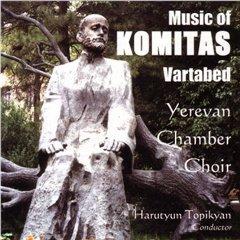Music of Komitas Vartabed - Yerevan Chamber Choir (2000)
Music of Komitas Vartabed - Yerevan Chamber Choir (2000)

1. Wedding songs 2. This night, moonlight night 3. Start the music 4. Armenian folk songs/dances, Vol.3 5. Harvest song 6. Threshing song 7. Through the mountains 8. The beaming maiden 9. Lullaby 10. Armenian provincial songs/dances, Vol.4 11. The waters of lake Bingeol 12. The grinding song 13. I have five goats 14. What a sweet thing 15. Let there be a breeze 16. My sweet Sona 17. Let the nightingale be silent 18. Plowing song 19. A poetic ode to the Holy Mother of God Yerevan Chamber Choir Harutyun Topikyan - conductor
Komitas Vartabed, whose given name was Soghomon Soghomonian, was born in 1869 at Gudina in Asia Minor. Orphaned at 11, he was sent to live in the monastery at Etchmiadzin, the See of the Armenian Apostolic Church. His talent as a singer brought him to the attention of Catholicos Kevork IV, who determined that the youth should be nurtured and encouraged. In 1893, Soghomon entered the priesthood of the Armenian Church and was given a new name, Komitas, at his ordination in accordance with Armenian Church tradition. Two years later, he was elevated from the rank of a simple priest to that of Vartabed. A talented musician, Komitas Vartabed traveled to Berlin to continue his musical studies at the conservatory and later at the Frederick Wilhelm Imperial University. In 1899, he graduated having earned the title of Doctor in Musicology. Komitas Vartabed's major contributions to Armenian musical tradition are his collection of folk music, and his Badarak, or Divine Liturgy, of the Armenian Church. Komitas had become concerned that the music of the Badarak, which was passed down from priest to priest, had been inordinately influenced by the secular music common in the various regions where Armenians lived. In an exhaustive effort to restore the traditional melodies of the liturgy, he traveled widely to rural Armenian villages in search of old priests; he reasoned that their chanting would be closest to the original melodies of the liturgy.
His efforts to restore the true sounds of the Armenian liturgical music tradition reach us today in the form of his Badarak, most notably the version written for three-part mens chorus, which was his personal preference. It is, however, in his works based on simple folk melodies, such as those on this CD, that one recognizes Komitas genius. Using simple musical elements he is able to create works of great depth and sensitivity that both challenge performers and enthrall listeners. On April 24, 1915, the day marking the beginning of the Armenian Genocide, Komitas Vartabed was imprisoned in Constantinople along with nearly 200 other intellectuals. Miraculously, he survived and was released after a long imprisonment, but his collected works and research were partially destroyed and left in disarray. This tragedy, coupled with the suffering he saw among his people, was more than he could bear. Physically and mentally weakened for the remainder of his years, he was unable to complete his life's work. Komitas Vartabed died in Paris on October 22, 1935. Thanks to the efforts of Armenian musicologists and musicians, much of Komitas' music is continuing to be researched and resurrected. Komitas Vartabed is acknowledged to be the premier Armenian composer and musicologist of his time. His works, both secular and religious, are performed today throughout the world.
On this CD native Armenian Harutyun Topikyan conducts the Yerevan Chamber Choir, who are acclaimed for their performances of Komitas Vartabed's music. ---amazon.com
download (mp3 @320 kbs):
yandex 4shared mega mediafire zalivalka cloudmailru uplea
Zmieniony (Piątek, 15 Kwiecień 2016 12:53)








